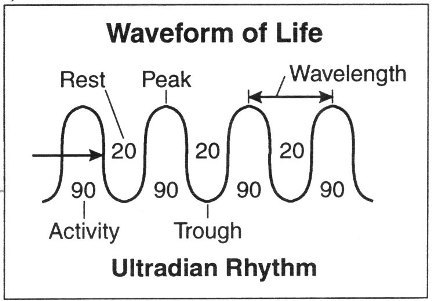 |
| This looks scientific. It must be true. |
Then the internet brought me to a site called Asian Efficiency, or more specifically, an article titled Hero Mode: How To Turn On Your Productivity Super Powers. (His title is probably better than mine, albeit too academic [it has a colon] for my taste.) Here's the super quote:
Every 90 to 120 minutes or so your body goes through an ultradian rhythm. This is what causes you to have different periods of alertness and drowsiness throughout the day. Each ultradian starts off with alertness but after 90 minutes or so, this starts to fade away and your body wants to rest and take a break. This is when you start to get hungry, you yawn, you’re most likely to procrastinate, you find it difficult to concentrate and you want to stretch your body.You're welcome to just read his article. (At least I think it's a he. I'm not familiar with Asian name gender.) In a nutshell, when your 90-120 minutes of awesome are up, you get up, get a drink of water, have a 300 calorie snack/meal, and relax for about 20 minutes. This is far better than getting a shot of caffeine to force yourself to keep moving. (Have you ever seen a teacher with a Diet Coke? You have?!)
Now for the teaching application.
A school day for me lasts 6 hours 45 minutes, with 25 minutes for lunch and five minutes between class. With seven periods in a day, my classes last around 45 minutes each. According to ultradian rhythms, this is bad news. (High school is calling my name with those enticing 90 minute periods, but even they aren't quite there.) According to ultradia, if students were most productive during the first 90 minutes of school, third period would be the time for the burnout. It just dawned on me that between my graphic design periods, which are periods 2, 3, and 4, period 2 almost always performs better than the other two. Confirmation bias, coincidence, or causality?
Ideally, a period would last 90 minutes, followed by a 20 minute break, which has water, food, and non-learning activities.
But obviously I'm not in a position to make such a change, so how can I use this information to my immediate advantage? In all my classes, I'm attempting to jumpstart students with a quick activity to begin class. Maybe for third and fourth period, they don't need a jumpstart, they need a break. In a 45 minute period, I don't have 20 minutes to spare, but maybe a 5-10 minute video, activity, or game would do the trick. With any luck, it'll reset their ultradia and not only will they perform better in my third period, but in their next class as well.
However, this is all assuming that first period is when students have their first 90 minutes of awesome. For boys this might be true, considering it's their first time thinking for the day. Girls, on the other hand, tend to use their brains when getting ready for school. Hopefully that's about 110 minutes before school starts, accounting for the 20 minute break of waiting for and sitting on the bus.

No comments:
Post a Comment